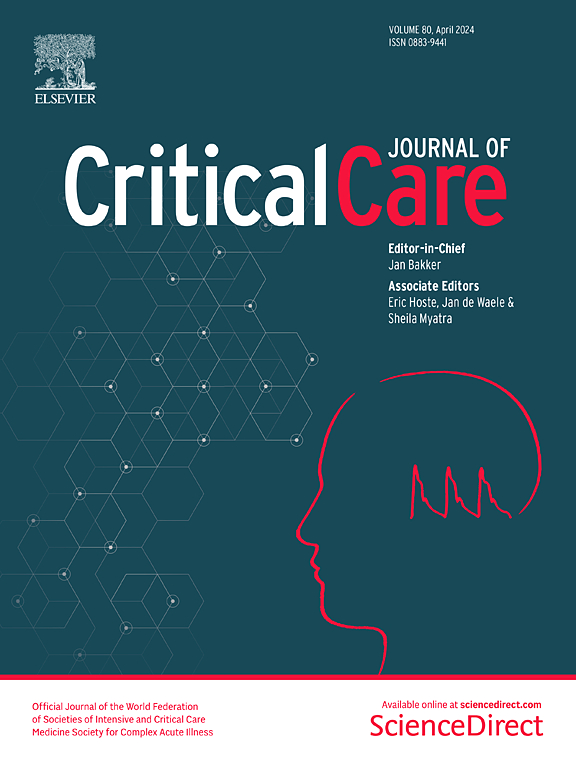日本败血症和感染性休克管理临床实践指南(J-SSCG) 2020对现实世界依从性和医院间差异的影响:一项全国住院患者数据库研究
IF 8.8
1区 医学
Q1 CRITICAL CARE MEDICINE
引用次数: 0
摘要
日本败血症和感染性休克管理临床实践指南(J-SSCG) 2020旨在规范日本的败血症护理。然而,它们对临床实践的影响程度仍不确定。我们在2018年4月至2021年12月期间使用日本诊断程序组合数据库进行了一项全国性的回顾性队列研究。在J-SSCG 2020的118个临床问题(cq)中,我们确定了26个建议,可以使用患者水平的数据来评估其依从性。我们使用中断时间序列分析评估指南发表前后的依从性趋势,并使用类内相关系数量化医院水平的变化。共纳入791家医院的213099例败血症患者。各cq的依从率差异很大(范围:0.5-98.7%)。“反对”干预措施的建议通常表现出较高的依从性,而“支持”干预措施的建议则表现出较低的依从性和更多的变数。指南发表后,大多数cq的依从性提高了< 3%。中断时间序列分析显示没有突然或实质性的变化,统计上显著的趋势是温和的(每年< 2%)。26个cq中,与J-SSCG 2016一致的有14个,2020年新引入的有12个;两组在依从性方面都表现出相似的有限变化。22个cq的校正类内相关系数超过10%,表明医院间持续存在差异,在指南发布后保持不变。这项全国性的研究确定了持续存在的证据与实践差距,J-SSCG 2020后依从性的最小改善,以及大量的医院间差异保持不变。这些发现强调了在实践中实施指南的挑战,并强调需要更好地了解日本标准化败血症护理的背景障碍。本文章由计算机程序翻译,如有差异,请以英文原文为准。
Impact of the Japanese clinical practice guidelines for management of sepsis and septic shock (J-SSCG) 2020 on real-world adherence and interhospital variation: a nationwide inpatient database study
The Japanese Clinical Practice Guidelines for Management of Sepsis and Septic Shock (J-SSCG) 2020 aimed to standardize sepsis care in Japan. However, the extent of their impact on clinical practice remains uncertain. We conducted a nationwide retrospective cohort study using the Japanese Diagnosis Procedure Combination database between April 2018 and December 2021. Of the 118 clinical questions (CQs) in the J-SSCG 2020, we identified 26 recommendations to which adherence could be evaluated using patient-level data. We evaluated adherence trends before and after the guideline’s publication using interrupted time series analysis and quantified hospital-level variation using intraclass correlation coefficients. A total of 213,099 patients with sepsis from 791 hospitals were included. Adherence rates varied widely across CQs (range: 0.5–98.7%). Recommendations “against” interventions generally showed high adherence, whereas those “for” interventions exhibited lower and more variable adherence. After guideline publication, adherence increased by < 3% points for most CQs. Interrupted time series analysis demonstrated no abrupt or substantial changes, and statistically significant trends were modest (< 2% annually). Among the 26 CQs, 14 were consistent with J-SSCG 2016 and 12 were newly introduced in 2020; both groups showed similarly limited changes in adherence. Adjusted intraclass correlation coefficients exceeded 10% for 22 CQs, indicating persistent between-hospital variation, which remained unchanged after the guideline’s release. This nationwide study identified persistent evidence–practice gaps, minimal improvements in adherence after J-SSCG 2020, and substantial interhospital variation that remained unaltered. These findings underscore the challenges of implementing guidelines in practice and highlight the need to better understand contextual barriers to standardized sepsis care in Japan.
求助全文
通过发布文献求助,成功后即可免费获取论文全文。
去求助
来源期刊

Critical Care
医学-危重病医学
CiteScore
20.60
自引率
3.30%
发文量
348
审稿时长
1.5 months
期刊介绍:
Critical Care is an esteemed international medical journal that undergoes a rigorous peer-review process to maintain its high quality standards. Its primary objective is to enhance the healthcare services offered to critically ill patients. To achieve this, the journal focuses on gathering, exchanging, disseminating, and endorsing evidence-based information that is highly relevant to intensivists. By doing so, Critical Care seeks to provide a thorough and inclusive examination of the intensive care field.
 求助内容:
求助内容: 应助结果提醒方式:
应助结果提醒方式:


